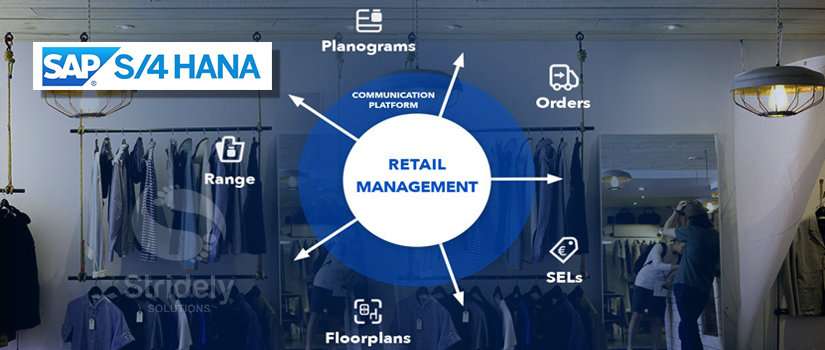SAP S/4HANA is an advance enterprise resource planning solution that comes with in-built intelligent technologies such as machine learning, AI, and complete analytics system. This application suite allows retail businesses to improve their business models, while offering them insights to crucial operation data. It also empowers them with real-time, contextual information for better and faster decision-making.
Besides the above, the solution also provides users the agility and flexibility needed for ensuring best in the class customer experiences. The intuitive and simple interface of SAP empowers the retailers to create faster and smarter retail solutions by leveraging forecast foundation and data set provided by the system. In other words, it simplifies their business processes and IT landscape for unlocking business innovation.
Success Case: SAP S/4 HANA Implementation On Cloud: Machinery Manufacturing Company
Let’s see how it is highly useful and feature-rich for retail management purpose for the enterprises.
SAP S/4HANA – Usability
SAP S/4HANA is deployed in the cloud system of the companies of all industries and sizes. However, there are several factors that are considered to determine the factors that requires this system and its usability for their retail business.
The system builds actually guards the applications for encouraging clean data entry. With this system in place there is no need for creating inflexible tools for accommodating the day to day requirements of the user and business that keep changing from time to time.
The particular needs of the users is to be considered here when it comes to automating the system using SAP S/4HANA. Also, it is important to find the right balance between budgets and product backlog of the retail business. With system in place the users can get continuous feedback which not enhances the development process but also allows the project team to deploy their resources on various functionalities that can prove out to be more valuable for the end users.
When it comes to improving the usability it’s important to find the right tools for the job considering the following aspects –
- Form factor where the system is to be implemented – Determine whether the user will access the functionality from a handheld scanner, desktop, or tablet.
- What kind of decision is to be made by the user – Do the user needs the application for interaction purpose, or merely exporting a report to Excel serve as a better option for reaching that decision?
- Whether extra money and time is required for customizing UI5 development for adding all relevant features – or is it important to use ABAP RESTful for creating a simple and quick Fiori application.
Also Read: Why is it Essential for You to Migrate to SAP S/4HANA Right Now?
Keeping the above listed consideration in mind allows businesses to ensure a better user experience while helping them to avoid mistakes that may otherwise arise if a wrong tool is built for retail management.
End users’ choices and preferences are to be focused here as SAP S/4HANA for retail management is primarily implemented for them. And they will be the ones interacting with this system on a regular basis.
Accepting and embracing the technology has become need of the hour as it makes the lives of individuals easier. Optimal usage of the application is important for retailers to improve the overall data quality as it is the main element empowering their analytical tools.
SAP S/4HANA – Features
By introducing S/4HANA, SAP has ensures a much more modern and personalized user experience in comparison to SAP GUI. However, during the implementation process it is challenging to customize that experience for user base of a specific retailer as it involves a number of activities such as custom programs testing, system configuration, interface building, data conversion and more.
Also Read: The Right Time to Migrate to SAP S/4 HANA
Read on explore the application’s major features to learn how it benefits in retail management –
Enables Multi-Level Contract –
A proper procurement process is important for the retailers to meet the industry standards. It provides them the ability of maintaining stock and supply orders with suppliers in advance. Making precise decisions is difficult at early stages.
SAP S/4HANA’s multi-level contract feature allows retailers to consider high level commitments and provide additional details to the supplier later on. In the meantime, it gives retailers the flexibility of reacting to the market changes. The feature eliminates the possibilities of overstocking and allows retailers to maintain a healthy relationship with their suppliers.
Flexible commitment contract is though an old concept but today it has a number of new features. It allows the users to sign a ‘source contract’ with their vendors (mentioning generic article only for the meanwhile), and the exact variants can be specified later.
Fulfils Purchase-to-Order or Third Party Order efficiently –
SAP S/4HANA allows users to handle decoupling of purchase order and sales order articles in case a customer reduces the order quantity or cancels a sales order.
SAP S/4HANA eases the work of retailers that comes with a purchase order cancellation. With this application in place they need not to deal with exhaustive system changes as the entire process is automated. Moreover, retailers need not to create any new buying orders as the system automatically checks what all items are available in the stock and whether they are sufficient for fulfilling new sales orders.
Also Read: Confused about whom to choose as SAP HANA Managed Services Cloud provider?
However, it is to be noted that the system works efficiently when the article/merchandise of the required variety are aligned. The alignment of purchase-to-order or third-party order items with the freely available, pre-existing purchase order articles enable optimal consumption of purchase order items.
Handling pre-pack purchase orders –
Pre-pack handling requires flexibility as the retailers may not be aware of the exact structure or composition of a pre-pack article at the early stages of the process but still want a purchase contract to secure their order for generic articles which may become the part of pre-pack or structured article later on. The pre-pack components mentioned in the purchase call-off contract can be taken as the reference.
Data change automation –
The application’s smart features allows retailers to differentiate between different use cases. It allows the customers to easily access the item collection. Plus, retailers can add new collections and styles and remove collections or styles from the list. Moreover, they can modify the priority. All these processes are automated by the application.
Value Added Services features –
Earlier users could add a VAS to their merchandise or product but it involved the risk of transpiration if a particular plant or center involved in distribution couldn’t carry out the service or fulfill the request. The advance SAP S/4HANA can now easily combat this issue as it comes with a ‘plant capability check’ feature. An order document for stock transport and sales order inclusive of VAS isn’t allowed if the order can’t be provided in a particular location.
Re-determining seasons for various items –
The advanced Season Master Data feature of SAP S/4HANA gives users an indication whenever a new season re-determination is required. After the Season Completeness application is processed for an order item, an indicator for season completeness indicator is assigned to it for avoiding seasons’ redetermination for articles with a pre-determined season.
Handling workflow and class-based events –
Users can handle events with exceptions such as the ones related to orders un-assignment. The system raises a class-based event when deviation in the orders. They can be managed easily within the standard workflow framework where the configuration of ‘triggering event’ takes place for performing the particular tasks.
Prioritization of dynamic supply –
It offers the ability of supplying assignment and manages the supply according to the different supply varieties and time intervals. Such as, warehouse stock and on-hand can be considered as a short notice demand whereas the demand which is to be shifted to the later stages can be kept for future supply. The SAP Fiori application’s ‘Configure Supply Sort Rule’ can be considered for rescue as it allows users to prioritize specify time and different types of supply.
Evaluation of Documents by Supply Demand Overview –
Earlier, the Supply Demand Overview displayed data and info of ARun related items. The users couldn’t a detailed picture of the objects through it. SAP S/4HANA is now capable of visualizing the entire supply and demand status with the help of data sources including Open Supply, Temporary Assignments, Open Demand, Preview Assignments, and Normal Assignments.
Demand selection as per supply –
At times it is important to identify the various elements of demand assigned to a supply. For example – inbound for outbound process that allows the users to stay updated of the incoming deliveries related to supply assignment but you want details of demand elements that are assigned for the process. The enhanced version for ITA has comes with two new tabs allowing STO and SO selection by the supply assigned for the purpose. The selection criteria of the new tabs can be used for selecting the current assignments.
The Final Takeaway
User experience is one of the major aspects that the retailers need to consider when implementing SAP S/4HANA. Building the right support and functionality for the project can be done easily by the implementation team by engaging the users in the process. The settings can be made relevant for various SAP S/4HANA Retail business apps by getting them customized for General Logistics, Distribution and Sales, Cross-Application Components, and Materials Management.
Start Leveraging SAP S4HANA for Retail Management
Stridely Solutions can deploy SAP S4HANA for enterprise digitization or help you migrate from your legacy systems to it – fully or partially. For retail businesses, we utilize the best industry practices and optimize the IT spending positively. Whether you want to get started right now or need consultation services first, Stridely SAP experts are available to mentor and work with you.


